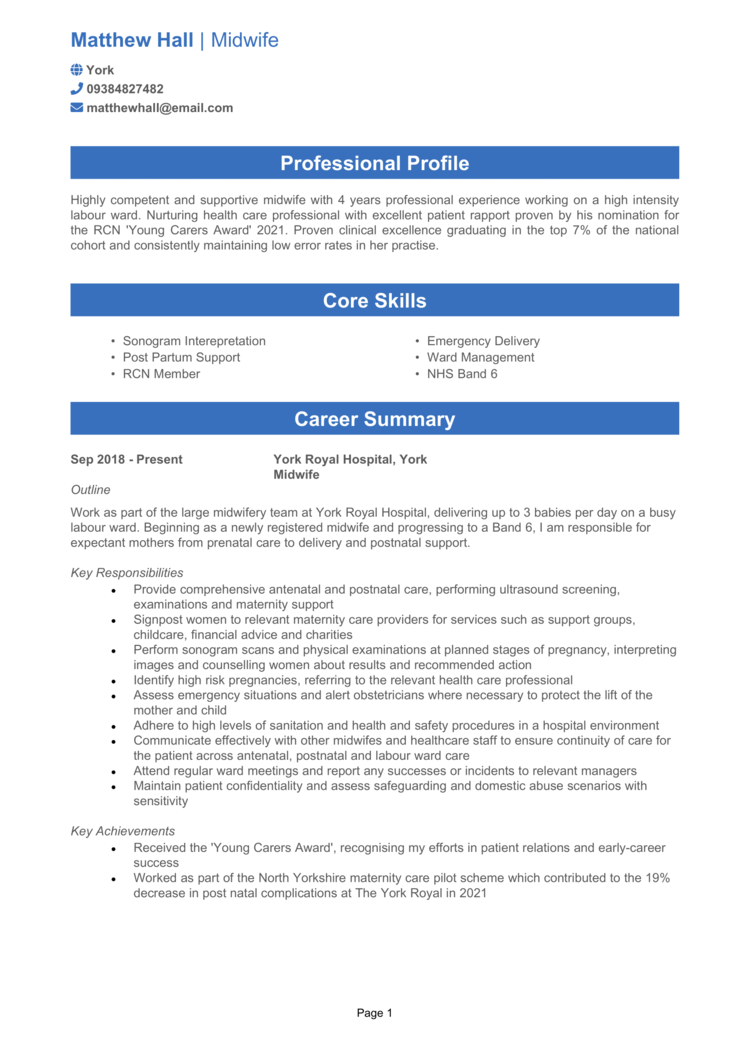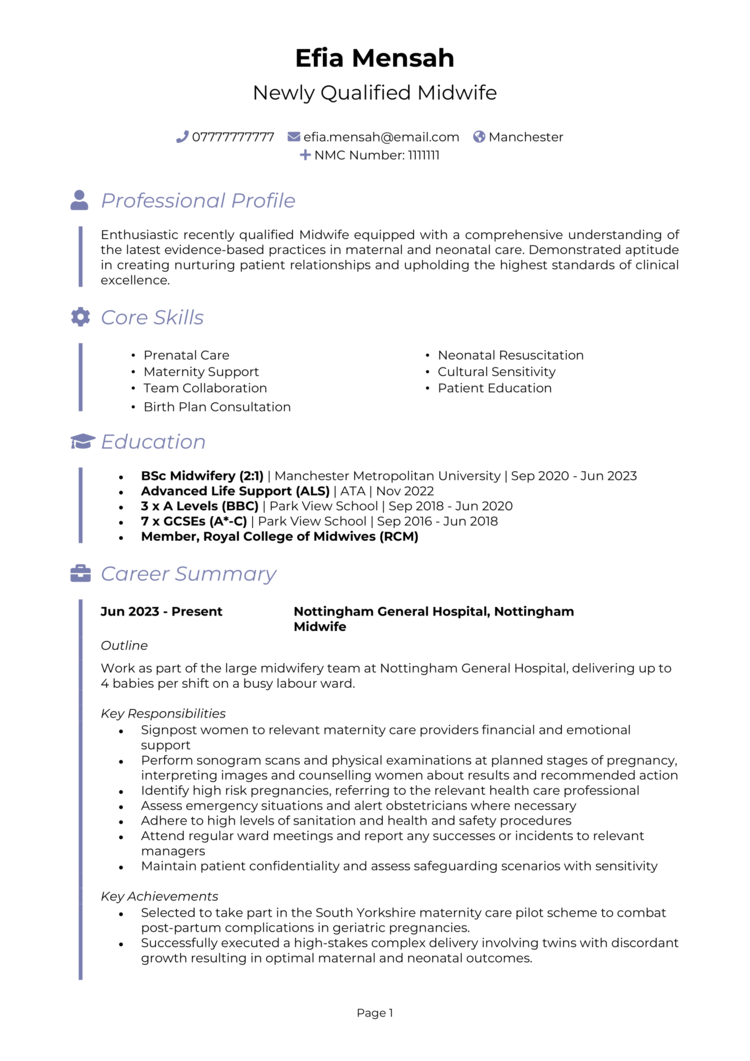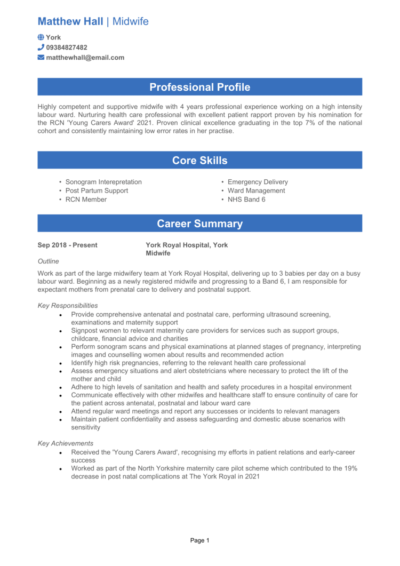As a midwife, you’ll get to provide care and expert guidance during some of life’s most profound moments.
But before you can bring your empathy and clinical expertise to your next midwifery role, you’ll need a CV that clearly showcases that you’re a skilled healthcare professional, an advocate, and a reassuring presence families rely on.
This guide, along with the included Midwife CV examples, will help you clearly demonstrate that you’re the person employers want by their side.
Midwife CV

Student Midwife CV

Newly Qualified Midwife CV

How to write your Midwife CV
Discover how to craft a winning Midwife CV that lands interviews with this simple step-by-step guide.
Your CV needs to reflect your strengths as clearly as you reassure a nervous parent. Employers don’t just want to see qualifications – they want evidence of your compassionate approach and your ability to calmly manage high-pressure situations.
This guide walks you through writing a CV in a way that clearly highlights your midwifery experience, specialised training, and the qualities that make you an outstanding healthcare professional. From antenatal to postnatal care, your CV will clearly show employers why you’re the midwife they trust to support families.
How should you structure and format a Midwife CV?


Your CV is your first chance to demonstrate the careful attention and clarity you bring to your midwifery practice. Just as patients rely on you to guide them through complex and emotional journeys, recruiters depend on your CV structure to quickly provide reassurance about your capabilities. Present your experience clearly and logically so that your strengths are immediately obvious.
To create an impactful CV, follow this layout:
- Name and contact details – At the top of your CV, clearly present your personal details, making it effortless for employers to reach out to you. A photo is completely optional.
- Profile – Start strong with a concise summary highlighting your most relevant midwifery skills, expertise, and compassionate approach to patient care.
- Core skills – Summarise key midwifery competencies, clearly demonstrating your suitability – whether it’s labour support, antenatal assessments, or neonatal care.
- Work experience – Clearly list your previous midwifery roles in reverse chronological order, giving the recruiters an immediate sense of your clinical experience and career progression.
- Education & certifications – Provide a clear overview of your midwifery qualifications and relevant professional training, showing your continuous commitment to patient safety and clinical excellence.
- Additional info – Optionally include extra details like professional memberships, awards, language skills, or hobbies, enhancing your overall profile.
Keep your format neat and professional, using clear headings and bullet points to make key information easy to find. Opt for a plain, readable font. A lengthy CV won’t impress anyone, so your CV shouldn’t exceed two pages – long enough to highlight essential information, but concise enough to keep busy recruiters fully engaged.
Writing a Midwife CV profile


Your CV profile should clearly highlight your midwifery experience, clinical skills, and compassionate care, reassuring employers that you’re the professional they’re after. Think of this as your introduction to employers – a snapshot that captures what makes you a reliable and highly skilled Midwife who will make a real, positive impact.
Midwife CV profile examples
Profile 1
Compassionate and highly skilled Midwife with five years of experience supporting women through pregnancy, labour, and postnatal care. Experienced in antenatal assessments, delivery assistance, and patient education. Skilled in managing both low-risk and complex births, with strong knowledge of safeguarding procedures and NHS guidelines. Committed to providing safe, respectful, and individualised care.
Profile 2
Dedicated Midwife with over four years of experience delivering high-quality maternity care in hospital and community settings. Proficient in monitoring foetal development, conducting health screenings, and supporting mothers during childbirth. Adept at working in multidisciplinary teams, offering emotional support, and ensuring positive birth experiences for patients and families.
Profile 3
Experienced Midwife with six years of practice in labour wards, birth centres, and home birth settings. Skilled in emergency response, pain management, and postnatal care planning. Proficient in using maternity software and patient record systems. Passionate about promoting maternal wellbeing and empowering women throughout their pregnancy journey.
Details to put in your Midwife CV profile
Here’s what to include:
- Midwifery experience – Highlight the breadth of your clinical experience across antenatal, intrapartum, and postnatal care.
- Clinical skills – Emphasise specific strengths, such as managing complex births, patient education, or neonatal care.
- Compassionate approach – Showcase your ability to provide emotional support and maintain calm in challenging situations.
- Specialist knowledge – Mention expertise in areas such as breastfeeding support, pregnancy complications, or homebirths.
- Career aims – Clearly indicate the type of midwifery role you seek, expressing your enthusiasm and commitment.
Writing an effective core skills section


Highlight the core skills that truly matter in the midwifery world – no vague fluff, just genuine expertise. Employers expect Midwives to combine clinical expertise with excellent interpersonal skills.
Tailor this section specifically to the type of role you’re targeting – hospital-based midwifery may emphasise different skills compared to community or specialist roles.
The top skills to highlight in your Midwife CV
- Antenatal Care – Monitoring the health of expectant mothers and their babies through regular check-ups, screenings, and education.
- Labour and Delivery Support – Assisting during childbirth, managing pain relief, and ensuring safe delivery for both mother and baby.
- Postnatal Care – Providing support and medical care to mothers and newborns in the days and weeks following birth.
- Emergency Response – Responding to complications such as haemorrhage or pre-eclampsia with prompt, skilled care.
- Newborn Assessment – Performing initial health checks, including APGAR scoring and newborn screenings.
- Health Education and Counselling – Advising parents on pregnancy, childbirth, infant care, breastfeeding, and family planning.
- Record Keeping and Documentation – Maintaining accurate, confidential medical records in line with healthcare regulations.
- Safeguarding and Emotional Support – Identifying and addressing emotional, psychological, or safeguarding concerns.
- Multidisciplinary Collaboration – Working with obstetricians, paediatricians, health visitors, and other professionals to ensure holistic care.
- Regulatory Compliance – Adhering to legal, professional, and ethical guidelines set by organisations such as the NMC.
Showcasing your work experience


Clearly showcase how you’ve effectively navigated the pressures, challenges, and joys of midwifery in your past roles. Your work experience should demonstrate clinical capability and the ability to work effectively within a multidisciplinary team.
If you’re newer to the profession, include placements or clinical training experiences that demonstrate relevant midwifery skills and professional development. List your previous midwifery roles in reverse chronological order, clearly highlighting responsibilities and successes, such as positive patient outcomes and management of particularly complex cases.
Writing job descriptions for past roles

- Outline – Briefly describe your role, the maternity service or hospital, and the patient group you supported.
- Responsibilities – Detail key duties such as antenatal assessments, labour and birth support, or postnatal care. Use clear action words like “assisted,” “monitored,” and “supported.”
- Achievements – Highlight measurable accomplishments like improved patient satisfaction, successful management of complex cases, or positive clinical outcomes. A useful tip is to sprinkle some numbers throughout wherever possible.
How to present past roles for a Midwife
Midwife | Lakeside NHS Trust
Outline
Providing maternity care for a busy NHS hospital, supporting patients through antenatal, intrapartum, and postnatal stages.
Responsibilities
- Conducted antenatal check-ups and health assessments, monitoring maternal and foetal wellbeing.
- Supported women during labour, managing pain relief and assisting with safe delivery.
- Delivered postnatal care, including breastfeeding support, safeguarding checks, and health education.
- Liaised with obstetricians, health visitors, and neonatal teams to ensure holistic patient care.
- Maintained accurate patient records using electronic maternity systems in compliance with NHS standards.
Achievements
- Supported over 200 successful births with consistently positive patient feedback.
- Recognised by senior staff for remaining calm and responsive in emergency situations.
- Improved appointment efficiency by introducing a new triage assessment tool.
Midwife | Ridgeway Community Centre
Outline
Supporting expectant mothers in a community-based midwifery unit, delivering continuity of care throughout pregnancy and birth.
Responsibilities
- Provided personalised antenatal care and education during home visits and clinic appointments.
- Led births within the centre, managing all aspects of labour and delivery in low-risk cases.
- Conducted postnatal check-ups and signposted families to community support services.
- Built trusting relationships with patients through consistent care and open communication.
- Ensured all care aligned with NICE guidelines and maintained detailed clinical documentation.
Achievements
- Achieved 95 percent patient satisfaction score in annual service review.
- Helped reduce hospital transfers by promoting early risk identification.
- Contributed to a patient-centred care plan model adopted across the trust.
Midwife | Northbrook Women’s Health Services
Outline
Delivering midwifery care across hospital and home birth settings for a regional women’s health provider.
Responsibilities
- Monitored pregnancies through regular assessments, blood tests, and ultrasound referrals.
- Managed labour and delivery, supporting both natural and assisted births.
- Offered emotional and physical support to mothers and families throughout the maternity journey.
- Participated in antenatal classes and parent education initiatives.
- Maintained compliance with safeguarding, infection control, and medication policies.
Achievements
- Successfully led home birth programme, increasing uptake by 30 percent.
- Recognised for excellence in maternal mental health support during postnatal care.
- Mentored three newly qualified midwives through their preceptorships.
Highlighting your education


As midwifery is a highly regulated healthcare profession, your educational background and certifications are crucial. Clearly list your midwifery degree, professional registrations (NMC registration), and relevant certifications.
Talk about ongoing professional training in areas such as emergency procedures, safeguarding, breastfeeding support, or neonatal care to show your commitment to continuous learning. Overall, this section should be relatively brief, and you should keep the focus on your past experience.
The best qualifications to boost a Midwife CV
- BSc Midwifery (NMC-approved) – Essential qualification for UK midwives.
- NMC Registration – Mandatory professional registration demonstrating clinical competency.
- Advanced Life Support in Obstetrics (ALSO) – Training to manage obstetric emergencies.
- Neonatal Resuscitation Training – Essential clinical training in newborn care.
- UNICEF Baby Friendly Initiative (BFI) Certification – Highly regarded qualification in breastfeeding support and infant feeding practices.





